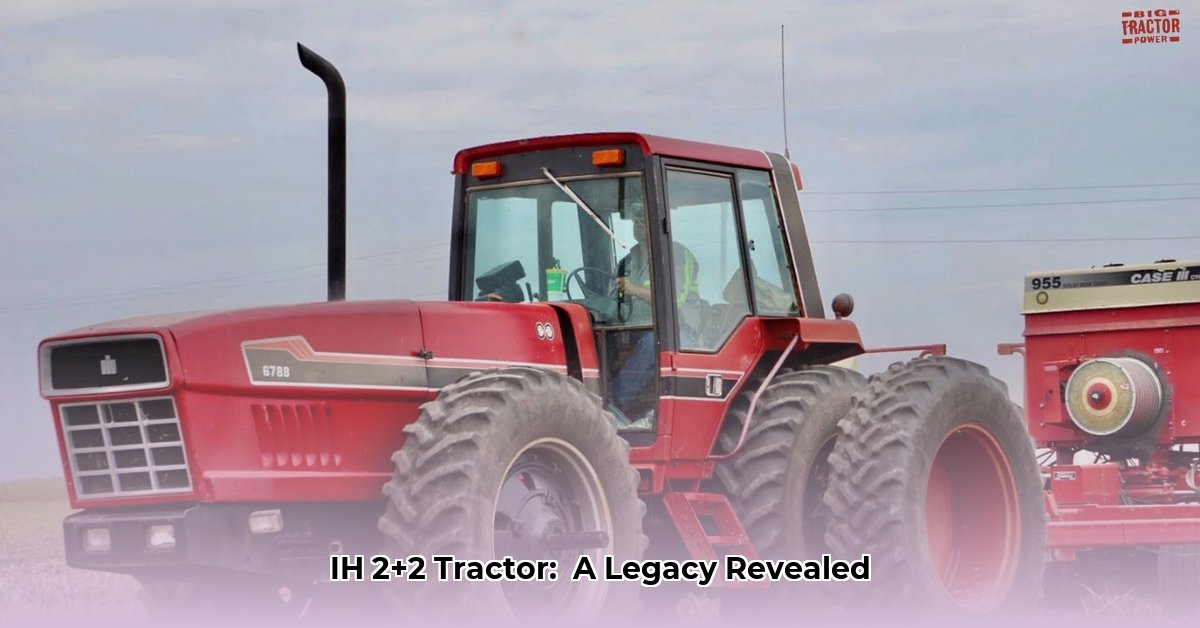
The International Harvester 2+2 tractor, a late 1970s marvel, stands as a testament to both innovative engineering and the pitfalls of ambitious design. Its unique rear-mounted driver's position and low-slung engine weren't mere stylistic choices; they were integral to a revolutionary approach to traction. But this bold experiment wasn't without its challenges, resulting in a story as complex as the machine itself. This article delves into the 2+2's triumphs and tribulations, exploring its design, performance, market impact, and ultimate demise. We'll also offer practical advice for those who dare to own this iconic, if somewhat controversial, piece of agricultural history. For more on classic tractor models, check out this helpful resource.
A Rear-Engine Revolution: Design and Engineering
Unlike its contemporaries, the IH 2+2 boldly placed the driver behind the powerful DT466 engine. This unconventional layout, however, wasn't just a quirky aesthetic decision. By positioning the engine low over the front axle, International Harvester aimed for superior traction—a critical factor in challenging field conditions. Imagine the scene: the engine, nestled low to the ground, provides an almost unfair advantage. Where other four-wheel-drive tractors struggled, the 2+2 seemed to simply dig in, its powerful tires churning through mud with remarkable ease. But this innovative design, while offering superior grip, would eventually become its Achilles' heel. Did this unconventional design ultimately outweigh its inherent weaknesses? Let's explore further.
Unmatched Traction, Troubled Transmission: Performance and Limitations
Field tests showcased the 2+2's impressive pulling power. With engine options delivering between 130 and 170 PTO horsepower (depending on the model—the 3588 being a particularly popular variant), it handled even the most demanding tasks with apparent ease. The 2+2's exceptional traction, particularly noticeable on steep slopes and in muddy conditions, was a significant advantage. However, this performance came at a cost. The remarkable grip wasn’t enough to compensate for a significant weakness: its final drive. This crucial system, responsible for transferring power to the wheels, proved remarkably susceptible to wear and tear, especially under the strain of the powerful DT466 engine. Farmers frequently reported premature failures, leading to substantial repair bills and significant downtime. Even retrofitting components from more robust tractors, such as the 1086 and 1586, failed to fully address this persistent problem. Was this inherent mechanical vulnerability the ultimate factor in the 2+2’s short lifespan?
An Acquired Taste: Market Reception and Legacy
The 2+2's striking appearance, to put it mildly, wasn't universally admired. Its unconventional design earned it nicknames like "anteater" and "land shark," highlighting a perception that may have impacted its market success. International Harvester countered with aggressive marketing showcasing the tractor's capabilities, hoping to counter the visual concerns with compelling demonstrations of its powerful performance. Despite these efforts, the persistent final drive issues, combined with its divisive aesthetics, ultimately limited the 2+2's market lifespan. Following the Case-IH merger, the tractor was discontinued. Yet, despite its relatively short career, it left its mark. Its remarkable traction capabilities and innovative design continue to fascinate tractor enthusiasts and collectors to this day, a testament to its unique place in agricultural history. How did this innovative design ultimately impact its legacy amongst farmers?
Key Takeaways: Three Pivotal Points about the IH 2+2
- Revolutionary Traction: The 2+2's unique design resulted in superior traction compared to its contemporaries, especially in challenging conditions.
- Persistent Final Drive Issues: The final drive's susceptibility to premature failure significantly hampered the tractor's reliability and market success.
- Controversial Aesthetics: The unconventional appearance proved divisive amongst farmers, potentially impacting its overall market acceptance.
Technical Specifications (Selected Models)
| Model | Engine | PTO Horsepower (approx.) | Weight (approx.) |
|---|---|---|---|
| 3388 | DT466 | 130 | Data unavailable |
| 3588 | DT466 | 150 | Data unavailable |
| 3788 | DT466 | 170 | Data unavailable |
Maintaining Your IH 2+2: Practical Advice and Preventive Measures
Owning an IH 2+2 is a testament to an appreciation for unique agricultural machinery. However, prospective owners must be prepared for the possibility of significant maintenance challenges. Given that the final drive was the major point of failure, preventive maintenance is paramount. This necessitates meticulous monitoring for unusual noises, leaks, and excessive play in the final drive system. Regular fluid changes, using the correct type and amount of lubricant, are also critical. Proactive care is your best defense against costly repairs. If you do encounter difficulties, thorough diagnosis is crucial before undertaking any repairs. Remember, working on a final drive requires mechanical expertise and specialized tools; professional assistance may be necessary.
The Enduring Legacy of a Unique Machine
The International Harvester 2+2 tractor serves as a compelling case study in agricultural innovation. Its innovative design pushed boundaries, delivering exceptional traction. However, the persistent final drive problems underscored the critical importance of robust engineering throughout the design and manufacturing process. While its commercial life was shorter than hoped, its legacy as a unique and ambitious machine endures, reminding us that even the most powerful innovations can be felled by seemingly minor flaws.